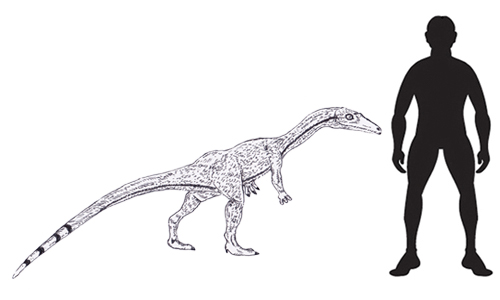Ghost Ranch Reveals Dinosaur Ancestor
Much is still unknown about the evolution of dinosaurs and how they came to dominate life on Earth as the mega fauna for around 160 million years. However, the findings of young palaeontologists from the University of California may shed some new light on the rise of the dinosaurs and the type of animals that shared the Late Triassic with them.
Ghost Ranch Fossil
These palaeontologists working on specimens from the famous Ghost Ranch area of New Mexico have unearthed an ancestor of the dinosaur – an animal commonly referred to as a “basal dinosauromorph”. Working on sediments aged between 220 – 210 million years old, the graduates have uncovered fossils of a wide range of animals that give an insight to the type of animals that co-existed with the first dinosaurs. Remains of dinosaurs, amphibians, fish and ancient crocodiles have been recovered, surprisingly a number of animals thought to be precursors of the dinosaurs have also been found. It had been thought that these ancestral forms had died out around 230 million years ago, paving the way for the true dinosaurs to take over. However, it looks like some of these ancient reptiles survived into the late Triassic and shared the world with the early dinosaurs.
Most of the animals around during this time were relatively small (at least compared to their later Jurassic and Cretaceous counterparts). Dinosaurs such as Coelophysis were no more than 3 metres long. One dinosaur ancestor represented by a Ghost Ranch fossil, named Dromomeron romeri, ( pronounced Dro-mo-mer-on Ro-mer-eye) was only half this size and like Coelophysis it may have been a fleet footed, meat-eater chasing after prey by running on its long hind-legs.
A Scale Drawing of Coelophysis
Picture credit: Everything Dinosaur
The picture (above) shows a scale drawing of Coelophysis based on a Coelophysis replica from the Wild Dinos model range>
To view this range: The Wild Safari Prehistoric World Model Range.
Dinosauromorphs
Previously, scientists had thought that the dinosaurs rose to prominence quickly and animals like Coelophysis out competed the dinosaur precursors quickly driving them to extinction. However, based on this evidence from New Mexico it looks like ancestral dinosauromorphs hung around longer than we thought.
There is still very little material from the middle and late Triassic period to study, there are very few fossil sites dating from this time in our planet’s history. The evidence for the evolution and ascent of the dinosaurs is still very patchy to say the least.
These small dinosaurs and basal dinosauromorphs were not on top of the food-chain, the dominant predators at the time were other Archosaurs such as Postosuchus and Arizonasaurus – the fierce dinosaur hunter with a sail.
To see a picture of Arizonasaurus and other prehistoric animal models; click here: Prehistoric Animal and Dinosaur Models.
In truth after the massive extinction event at the end of the Permian the world’s ecosystems were thrown into chaos. It may have taken as long as 100 million years for animal and plant species to diversify to the extent seen before the Permian extinction.
Triassic Survivors
Strangely, some individual genera (similar or closely related species) survived for millions of years well into the Triassic. Often these were the only representatives from what were once very successful and diverse families. The scientist David Jablonski coined the phrase “Dead Clades Walking”, a description of an organism that may have survived a mass extinction but was unable to recover sufficiently to survive for much longer afterwards.
A typical example of a “Dead Clade Walking” is the Lystrosaurs which survived for some 30 million years before finally going extinct towards the end of the Triassic. David Jablonski was inspired by the films “Dead Man Walking” that starred Susan Sarandon and “The Green Mile” with Tom Hanks. Dead Man Walking is American prison guard slang for a condemned prisoner.







Leave A Comment